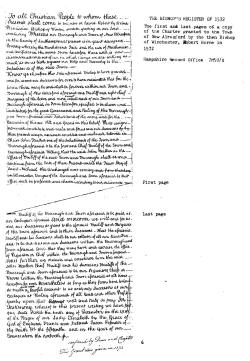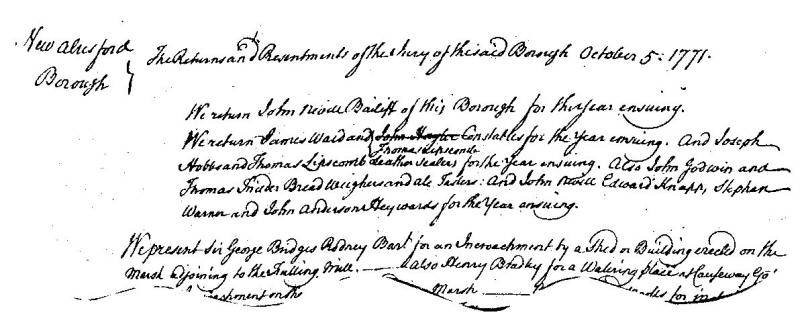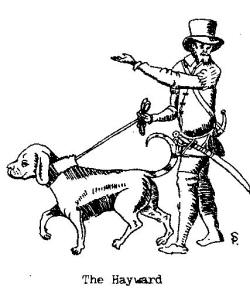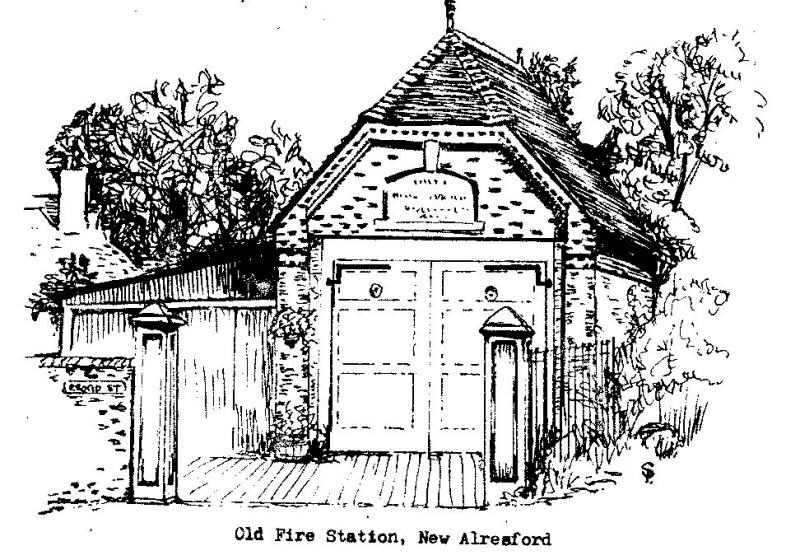THE BAILIFF AND BURGESSES OF NEW ALRESFORD
by John Adams.
Author's Note. A good deal of information contained in this paper has been extracted from researches carried out by Digby Grist, to whom the writer is indebted.
A century ago great changes were taking place in :Local Government and now, perhaps, is an appropriate time to review these. It is hoped, therefore, that this will be the first of three papers which will survey the functions of the Bailiff and Burgesses and then, as a result of Acts of Parliament, the division of their responsibilities for our town into the administration now performed by the New Alresford Parish Council and the charitable duties for which the New Alresford Town Trust is answerable to the Charity Commissioners.
Today, if you want to alter external appearance of your house, modify the nature of your business or make visible changes to your property, you will probably need the approval of the New Alresford Parish Council, the City of Winchester Council and the Hampshire County Council. If anyone objects to what you propose, their objections pass through the same set of hurdles and if these objections are sustained you can appeal to central government. Eventually if you are still alive you are at liberty to carry on with your project. This is probably an exaggeration but there are many decent residents of Alresford today who feel that they are living in the unreal atmosphere which the foregoing describes.
A hundred years ago and for the preceding four hundred years, things were much simpler in Alresford. You needed the approval of one body of men to carry out your project. The purpose of this paper is to explain who these men were and why we have inherited a successful and thriving township. They were the Bailiff and Burgesses. Nine local men who knew the town intimately and had in mind the success of the town rather than their own. They were self-elected and who recognised their corporate responsibility to ensure that the town thrived on behalf of its principal landlord - the Bishop of Winchester. Even when the Diocese 'had ceased to be of the Catholic faith, the influence of the Bishop continued to be felt in Alresford and the Burgesses his loyal agents.
But the township was being farmed out to secular interests. The estate known as Westercourts (of which Western Court Farm formed a part) became the property of Elizabeth I's Chancellor, Sir Richard Lyster on his retirement : the influence of the Tichborne baronet was felt in the town : the estates that were being developed around Bishop's Sutton and Old Alresford were too big to be ignored. Yet the Bailiff and Burgesses survived and continued to run the town on behalf of its tradesmen and its people.
It needed more than the arrival of big property owners to change Alresford. Even the Civil War and the Battle of Cheriton did not disturb the influence of the Bailiff and Burgesses.
Then came the disaster with which these men could not cope. On 1st May 1689, as described in another paper a fire destroyed the homes of 117 families, complete with their barns and warehouses. The Church was not re-opened for six years. We should be grateful to William and Mary, who instructed the congregations of all churches throughout the Kingdom to make contributions to the repair of the damage to Alresford. The bulk of the estimated loss was recovered in this way and after fifteen years the Town was on its way to thriving again: but any records prior to 1689 which had been kept in the church were destroyed: in the great fire.
 Amongst the many old wills which are preserved in the Hampshire
Record Office are a number which state that the testator lived in the
'Borough' of New Alresford. A charter granted to the Town vas lost in
one of the many fires it suffered but a later copy is in the Bishop's
Register of 1572 when Robert Horne was Bishop. Nine men of 'ye betar
and more honest Inhabitance of our town and Burrough were to be chosen,
one of whom was to be Bailiff whilst the others were named Burgesses.
These men were charged with the organisation of the fairs and markets
and the income from these activities was then to be applied according
to the resolution passed at the meetings of the Bailiff and Burgesses.
Amongst the many old wills which are preserved in the Hampshire
Record Office are a number which state that the testator lived in the
'Borough' of New Alresford. A charter granted to the Town vas lost in
one of the many fires it suffered but a later copy is in the Bishop's
Register of 1572 when Robert Horne was Bishop. Nine men of 'ye betar
and more honest Inhabitance of our town and Burrough were to be chosen,
one of whom was to be Bailiff whilst the others were named Burgesses.
These men were charged with the organisation of the fairs and markets
and the income from these activities was then to be applied according
to the resolution passed at the meetings of the Bailiff and Burgesses.
One Minute Book and One Account Book of the Bailiff and Burgesses are preserved in the Hampshire Record office. These reveal a great deal about the duties and administration with which the officials were concerned. For instance the Bailiff and borough officials - constables. bread weighers, ale tasters and Haywards (who looked after the fields) were elected annually. The extract from the Borough Court Book of 1771 records that (Admiral) Sir George Bridges Rodney Bart, was in trouble that year for an encroachment of a shed or building!
The Bailiff and Burgesses held a Court in ordinary to carry out the necessary business of the Borough. Extracts from the Court Book ' illustrate the variety of business dealt:
1685.The butchers are complaining that 'Divers and Foreign Butchers' have been selling their goods in front of the houses on market days instead of using the shambles for which they would have to pay a fee. The decision of the Court is that any offenders shall in future pay a fine of 3s 4d.
1706. John Grossmith leases a butchers' shamble from the Bailiff and Burgesses for which he pays a rent of one shilling. A note in 1764 records the removal of the shamble.
1771, The jurymen inform the court of misdemeanours committed. These include encroachments on the common waste and roads, failing to keep causeways in repair and the creation of nuisances (e.g. a dung heap in Jacklins (sic) Lane).

Extract from the Borough Court Book of 1771 recording the election of John Nevill as Bailiff and other men to various offices.
The Bailiff kept meticulous accounts of money received and payments made. In 1767 the Bailiff was Robert Boyes Master of Perin's School who notes a number of payments for repair of the causeway (presumably the Great Weir). In 1776 payments are recorded for building the Hurdle House on Pound Hill and for mending the Pound itself, the Pound key and the Public Gates, Under 1778 an intriguing entry appears - £1 9s for 'Runners before His Majesty' and 6s 6d for 'Musik'. Was George the Third paying a visit to George Rodney his favourite sailor? Moving on to 1848 we find that the Bailiff and Burgesses are now responsible for paying the Beadle's salary. The annual dinner was now a a tradition and £4, 6s 6d was paid for venison and - £1 18s 6d for turtle.
 In retrospect, it is apparent that through
the efforts of the Bailiff and Burgesses,
Alresford thrived. The streets were paved, schools were financed, the Avenue was landscaped
and planted up (this took six years), the poor were housed, the elderly were looked after, the
bellringers paid, an organ was purchased for the church, singing boys hired and the hymn books
bought. Fairs and markets were organised. In 1827 thirty two thousand sheep were sold at
Alresford market together with considerable numbers of horses, cattle and pigs. This with a population of just over
fifteen hundred. 1827 was not a special year - it happened that the
Bailiff that year was a local farmer who put the
figures into the account for interest.
In retrospect, it is apparent that through
the efforts of the Bailiff and Burgesses,
Alresford thrived. The streets were paved, schools were financed, the Avenue was landscaped
and planted up (this took six years), the poor were housed, the elderly were looked after, the
bellringers paid, an organ was purchased for the church, singing boys hired and the hymn books
bought. Fairs and markets were organised. In 1827 thirty two thousand sheep were sold at
Alresford market together with considerable numbers of horses, cattle and pigs. This with a population of just over
fifteen hundred. 1827 was not a special year - it happened that the
Bailiff that year was a local farmer who put the
figures into the account for interest.
The only reward the Bailiff and Burgesses got for all this was the afore-mentioned annual dinner - but it was a good one, held usually at the George or the Swan. Turtle and venison were invariably on the menu, probably sent down from London. Places like 'the Globe or the Sun 'or the Running Horse dealt with minor functions (there is a pencil note in the accounts for 1850 saying that the meal at the Sun should be at 3s 6d a head while that at the George should cost 4 guineas). Towards the end of the nineteenth century far reaching changes were taking place in local government. The Corporation of Bailiff and Burgesses was dissolved in 1886 when it failed to be granted a charter under the Municipal Corporations Act of 1882. It was replaced by the New Alresford Town Trust, a charitable body set up in 1890 with Trustees in whom the property of the Old Corporation was Vested and who administered the revenues of the old Bailiff and Burgesses. Responsibilities which we now associate with local government would be taken over by the New Alresford Parish Council, set up in 1894 and leaving the Town Trustees as a purely charitable institution responsible directly to the Charity Commissioners.
The Corporation was given a reasonable time to straighten out their accounts before being dissolved. How were they to commemorate their centuries of office in Alresford? A number of ideas was put forward. A popular one was to build a bathing pool down by the Globe. This was well supported until Mr. Hall of the Town Mill realised it would affect the supply of water to his mill wheel. However, what was agreed generally to be the right solution was found. One of the duties on which the Bailiff had not been conspicuously successful in the past was fire prevention. There had been three disastrous fires and many minor ones. The Corporation decided to provide Alresford with a fire engine. Then the question arose of where it was to be housed. One of the Burgesses, William Henry Hunt, was an architect; the wife of another, John Covey, had a piece of land at the bottom of Broad Street. The newly constituted Alresford Rural Sanitary Authority (whose sign on the Norman bridge has been restored recently by the present Town Trustees) could be persuaded to share half the cost of widening the road to get the engine out of the building on the site. Eddolls and Kemp - then carpenters - arranged some timber; Henry Hewitt provided bricks. Others helped, with John Pewsey making the iron gates. The Old Fire station, as it is now known, was built quickly at a cost of £130 to stand as a permanent memorial to the centuries old benign rule of the Bailiff and Burgesses; the caption above the doorway tells us the building was ''Erected by the Bailiff and Burgesses of New Alresford AD 1881". Although they did not get their engine immediately, it arrived in the end and it proved to be a major headache for their successors - but that is a story for another paper and the Alresford Fire Service.

Copyright John Adams October 1989.
Sources Hampshire Record Office - Minute Book of the Bailiff and Burgesses
- Account Book of the bailiff and Burgesses
- Minutiae